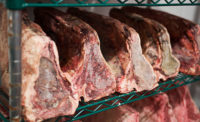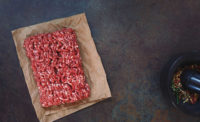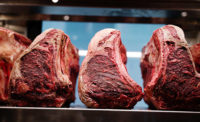Brazilian dry-aged beef consumption has increased between 2013 and 2018. Many restaurants and artisan butcher shops are developing and producing dry-aged beef. There is, however, no official standard regarding aging conditions such as temperature, relative humidity or time. Knowing the effects of different aging conditions on meat quality (sensory and microbiological), specifically for the kind of beef produced in Brazil, will help the meat industry, restaurants and butcher shops produce a better and more consistent product.
One of the main changes that occurs during the dry-aging process is moisture loss by evaporation. This leads to a dehydrated surface with low water activity that protects the meat from spoilage microorganisms. On the other hand, the moisture loss and crust formation increases the weight and trimming losses, reducing the saleable meat. To address the yield losses, scientists developed a special moisture-permeable plastic bag application for dry aging. This plastic bag application reduces the evaporative weight losses, thus increasing saleable meat yield.
We ran an experiment to evaluate the effects of two relative humidity (RH) levels (65 percent or 85 percent) on water loss of dry-aged strip loins unpackaged and packaged with a highly moisture-permeable bag. We applied two different aging times: 21 and 42 days.
Strip loins from Nellore intact males were collected at a commercial plant in São Paulo State. Carcasses were ~250kg and had slight fat cover, between 5 to 8 mm. A total of 16 beef loins (eight pairs) were sent to our meat lab at University of Campinas. Each pair of beef loin was cut into eight equal parts and assigned to each treatment combination. (two RH: 65% or 85%; two aging times: 21 or 42 days; unpackaged or packaged).
The aging chambers were set to desired RH and temperature (2ºC). All the samples were deboned and distributed between the treatments. Half of the samples were positioned inside the meat-aging chambers, unpackaged, and the other half were packaged in the dry-aging bags (Tublin 10, TUB-EX ApS, Denmark) and vacuum sealed. Samples were weighed and positioned within the aging chamber and rotated every three days.
Aging loss (evaporation and trim loss), moisture content and surface water activity were determined in the end of the experiment.
The presence of a bad smell and slime was detected after 21 days of aging on samples that were aged unpackaged at 85 percent RH. Those samples were discarded.
At 65 percent RH and 21 days of aging, unpackaged samples lost 19.6 percent of their weight, while samples aged packaged lost 17.5 percent. After 42 days, unpackaged samples lost 27.3 percent of weight, while samples aged packaged lost 24.4 percent. It shows the efficiency of reducing 2 to 3 percent of weight loss when using the dry-aging bag.
At 21 days of aging, evaporation loss was higher, as expected, for samples aged at 65 percent RH (19.6 percent), than at 85 percent RH (10.6 percent), in both packaged and unpackaged conditions.
In our experiment, the amount of crust, or trimming, removed after the aging process did not change among packaged and unpackaged samples or when samples were aged by 21 or 42 days. It was expected that samples unpackaged and aged for 42 days would increase the amount of crust to be removed, when compared with the shorter aging time. The trimming of all treatments was close to 15 percent.
The moisture content inside the muscle samples was 1.4 percent lower when unpackaged samples were aged at 65 percent RH (73.1 percent) than 85 percent RH (74.5 percent). The same tendency had been observed for samples aged in the dry-aging bag, where samples aged at 65 percent RH had 71.6 percent moisture and samples aged at 85 percent RH had 73.6 percent moisture. Another observation regarding the moisture content was the effect of time, Samples aged for more time had less water, which was expected.
Water activity is one of the most important aspects of prevention of meat deterioration during the dry aging process. All samples aged at 85 percent RH had water activity very similar to the fresh samples, close to 0.99, probably causing deterioration. On the other hand, at 65 percent RH, the water activity, measured on the meat crust, decreased enough to control the microbiological growth. We observed lower water activity values for samples aged 42 days without bag (0.92) at 65 percent RH. Samples aged with the bag, in the same condition, had a water activity value of 0.95.
This experiment indicates that the relative humidity during the dry aging process is very important to prevent deterioration. Under our experimental conditions of renovation and air velocity and chamber load, the application of 85 percent RH did not dry our samples, with or without the dry-aging bag. The use of the highly moisture permeable bags appears to be very favorable for the dry aging process of beef; however, the impact of the application of such bags on sensory attributes of the aged beef must be further investigated. NP



